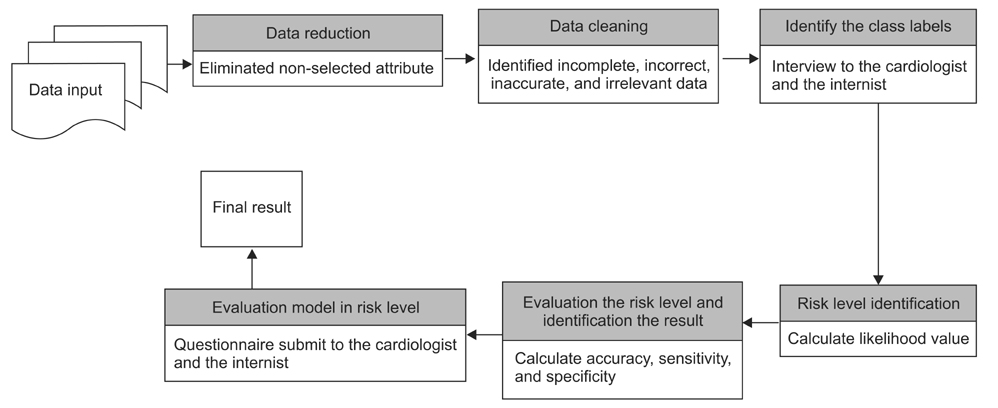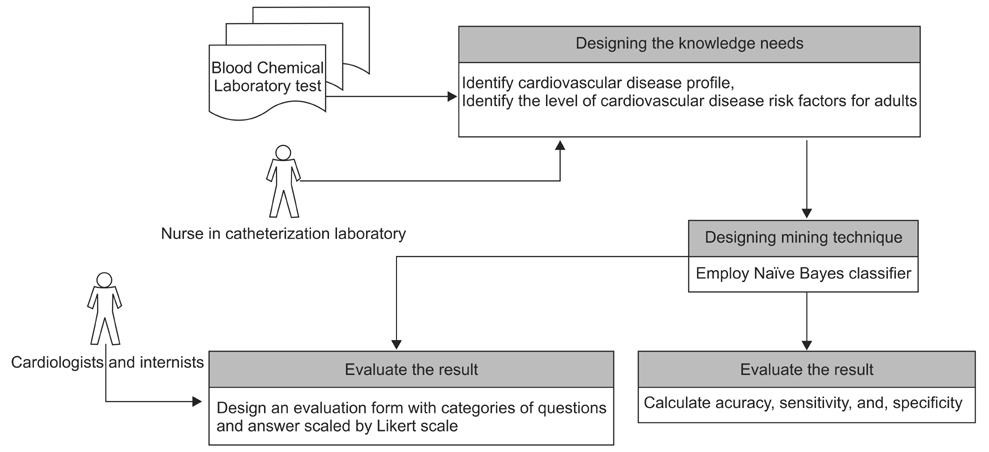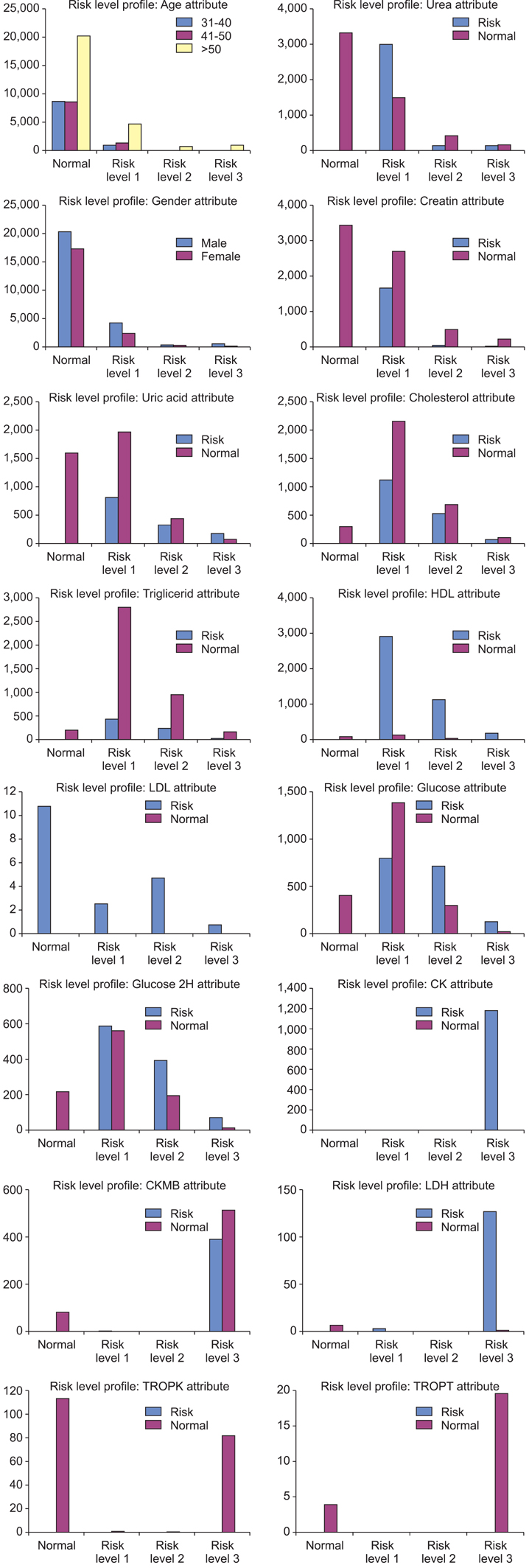Healthc Inform Res.
2016 Jul;22(3):196-205. 10.4258/hir.2016.22.3.196.
Detection of Cardiovascular Disease Risk's Level for Adults Using Naive Bayes Classifier
- Affiliations
-
- 1School of Information System, Bina Nusantara University, Jakarta, Indonesia. eirwansyah@binus.edu
- KMID: 2357398
- DOI: http://doi.org/10.4258/hir.2016.22.3.196
Abstract
OBJECTIVES
The number of deaths caused by cardiovascular disease and stroke is predicted to reach 23.3 million in 2030. As a contribution to support prevention of this phenomenon, this paper proposes a mining model using a naïve Bayes classifier that could detect cardiovascular disease and identify its risk level for adults.
METHODS
The process of designing the method began by identifying the knowledge related to the cardiovascular disease profile and the level of cardiovascular disease risk factors for adults based on the medical record, and designing a mining technique model using a naïve Bayes classifier. Evaluation of this research employed two methods: accuracy, sensitivity, and specificity calculation as well as an evaluation session with cardiologists and internists. The characteristics of cardiovascular disease are identified by its primary risk factors. Those factors are diabetes mellitus, the level of lipids in the blood, coronary artery function, and kidney function. Class labels were assigned according to the values of these factors: risk level 1, risk level 2 and risk level 3.
RESULTS
The evaluation of the classifier performance (accuracy, sensitivity, and specificity) in this research showed that the proposed model predicted the class label of tuples correctly (above 80%). More than eighty percent of respondents (including cardiologists and internists) who participated in the evaluation session agree till strongly agreed that this research followed medical procedures and that the result can support medical analysis related to cardiovascular disease.
CONCLUSIONS
The research showed that the proposed model achieves good performance for risk level detection of cardiovascular disease.
Keyword
MeSH Terms
Figure
Cited by 2 articles
-
Machine Learning to Compare Frequent Medical Problems of African American and Caucasian Diabetic Kidney Patients
Yong-Mi Kim, Pranay Kathuria, Dursun Delen
Healthc Inform Res. 2017;23(4):241-248. doi: 10.4258/hir.2017.23.4.241.Comparison of Models for the Prediction of Medical Costs of Spinal Fusion in Taiwan Diagnosis-Related Groups by Machine Learning Algorithms
Ching-Yen Kuo, Liang-Chin Yu, Hou-Chaung Chen, Chien-Lung Chan
Healthc Inform Res. 2018;24(1):29-37. doi: 10.4258/hir.2018.24.1.29.
Reference
-
1. Shouman M, Turner T, Stocker R. Using data mining techniques in heart disease diagnosis and treatment. Proceedings of Japan-Egypt Conference on Electronics. In : Communications and Computers (JEC-ECC); 2012 Mar 6-9; Alexandria. Egypt: p. 173–177.2. Ishtake SH, Sanap SA. Intelligent heart disease prediction system using data mining techniques. Int J Healthc Biomed Res. 2013; 1(3):94–101.3. Ministry of Health Republic of Indonesia. Healthy environment, healthy heart [Internet]. Jakarta: Ministry of Health Republic of Indonesia;2014. cited at 2016 Jan 17. Available from: http://www.depkes.go.id/article/view/201410080002/lingkungan-sehat-jantung-sehat.html.4. World Health Organization, Department of Health Statistics and Information Systems. Global Health Estimates: key figures and tables [Internet]. Geneva: World Health Organization;2016. cited at 2016 Jan 17. Available from: http://www.who.int/healthinfo/global_burden_disease/en.5. Ministry of Health Republic of Indonesia. Heart health situation [Internet]. Jakarta: Ministry of Health Republic of Indonesia;2014. cited at 2016 Jan 17. Available from: http://www.depkes.go.id/folder/view/01/structure-publikasi-pusdatin-info-datin.html.6. Marcovina SM, Crea F, Davignon J, Kaski JC, Koenig W, Landmesser U, et al. Biochemical and bioimaging markers for risk assessment and diagnosis in major cardiovascular diseases: a road to integration of complementary diagnostic tools. J Intern Med. 2007; 261(3):214–234.
Article7. Miao C, Bao M, Xing A, Chen S, Wu Y, Cai J, et al. Cardiovascular health score and the risk of cardiovascular diseases. PLoS One. 2015; 10(7):e0131537.
Article8. National Institutes of Health, National Heart, Lung, and Blood Institute. How is heart disease diagnosed? [Internet]. Washington (DC): National Institutes of Health;2014. cited at 2016 Jan 17. Available from: http://www.nhlbi.nih.gov/health/health-topics/topics/hdw/diagnosis.9. Sun X, Jia Z. A brief review of biomarkers for preventing and treating cardiovascular diseases. J Cardiovasc Dis Res. 2012; 3(4):251–254.
Article10. El-Sappagh SH, El-Masri S, Riad AM, Elmogy M. Data mining and knowledge discovery: applications, techniques, challenges and process models in healthcare. Int J Eng Res Appl. 2013; 3(3):900–906.11. Cortes PL, Cortes EG. Hospital information systems: a study of electronic patient records. J Inf Syst Technol Manag. 2011; 8(1):131–154.
Article12. Qiu Y, Zhen S, Zhou M, Li L. Continuously improve the medical care quality and hospital management level through medical information system construction. J Transl Med. 2012; 10:Suppl 2. A56.
Article13. Butler J, Kalogeropoulos A. Hospital strategies to reduce heart failure readmissions: where is the evidence? J Am Coll Cardiol. 2012; 60(7):615–617.14. Anbarasi M, Anupriya E, Iyengar NC. Enhanced prediction of heart disease with feature subset selection using genetic algorithm. Int J Eng Sci Technol. 2010; 2(10):5370–5376.15. Nishimura RA, Otto CM, Bonow RO, Carabello BA, Erwin JP 3rd, Guyton RA, et al. 2014 AHA/ACC guideline for the management of patients with valvular heart disease: executive summary: a report of the American College of Cardiology/American Heart Association Task Force on Practice Guidelines. J Am Coll Cardiol. 2014; 63(22):2438–2488.
Article16. Krum H, Driscoll A. Management of heart failure. Med J Aust. 2013; 199(5):334–339.
Article17. Holzinger A, Dehmer M, Jurisica I. Knowledge discovery and interactive data mining in bioinformatics: state-of-the-art, future challenges and research directions. BMC Bioinformatics. 2014; 15:Suppl 6. I1.18. Roque FS, Jensen PB, Schmock H, Dalgaard M, Andreatta M, Hansen T, et al. Using electronic patient records to discover disease correlations and stratify patient cohorts. PLoS Comput Biol. 2011; 7(8):e1002141.
Article19. Palaniappan S, Awang R. Intelligent heart disease prediction system using data mining techniques. Int J Comput Sci Netw Secur. 2008; 8(8):343–350.
Article20. Soni J, Ansari U, Sharma D, Soni S. Predictive data mining for medical diagnosis: an overview of heart disease prediction. Int J Comput Appl. 2011; 17(8):43–48.
Article21. Sakthimurugan T, Poonkuzhali S. An effective retrieval of medical records using data mining techniques. Int J Pharm Sci Health Care. 2012; 2(2):72–78.22. Chaurasia V, Pal S. Early prediction of heart diseases using data mining techniques. Caribb J Sci Technol. 2013; 1:208–217.23. Das R, Turkoglu I, Sengur A. Effective diagnosis of heart disease through neural networks ensembles. Expert Syst Appl. 2009; 36(4):7675–7680.
Article24. Sudhakar K, Manimekalai M. Propose a enhanced framework for prediction of heart disease. Int J Eng Res Appl. 2015; 5(4):1–6.25. Rajkumar A, Reena GS. Diagnosis of heart disease using datamining algorithm. Glob J Comput Sci Technol. 2010; 10(10):38–43.26. Jabbar MA, Deekshatulu BL, Chandra P. Classification of heart disease using k-nearest neighbor and genetic algorithm. Procedia Technol. 2013; 10:85–94.
Article27. Archana S, Elangovan K. Survey of classification techniques in data mining. Int J Comput Sci Mob Appl. 2014; 2(2):65–71.28. Han J, Kamber M. Data mining: concepts and techniques. 3rd ed. Amsterdam: Morgan Kaufmann;2012.29. Subbalakshmi G, Ramesh K, Rao MC. Decision support in heart disease prediction system using naive Bayes. Indian J Comput Sci Eng. 2011; 2(2):170–176.30. Wiharto W, Kusnanto H, Herianto H. Intelligence system for diagnosis level of coronary heart disease with K-Star algorithm. Healthc Inform Res. 2016; 22(1):30–38.
Article
- Full Text Links
- Actions
-
Cited
- CITED
-
- Close
- Share
- Similar articles
-
- Applying a Mutual Information Theory Based Feature Selection Method to a Classifier
- Application of Data Mining Technology in the Screening for Gallbladder Stones: A Cross-Sectional Retrospective Study of Chinese Adults
- Classification of Human Papillomavirus (HPV) Risk Type via Text Mining
- Identifying Disease of Interest With Deep Learning Using Diagnosis Code
- Comparisons of predictive modeling techniques for breast cancer in Korean women




